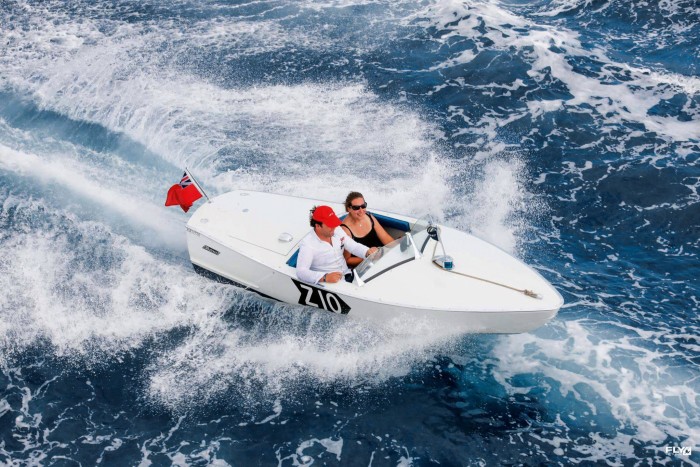Will you join the rush for retrotastic speedboats?

Roula Khalaf, Editor of the FT, selects her favourite stories in this weekly newsletter.
When I was eight years old my mother was employed by a newly moneyed gentleman who used his wealth to buy an idyllic clifftop holiday home where we all went to spend a summer. Much to my delight, he also ordered a Fletcher Arrow speedboat in Batman-like black and orange, fitted with a feisty, 50-horsepower Mercury outboard. He even allowed me to pilot it once or twice. I still have a faded Polaroid to remind me of those first forays on the water – the second of which was abruptly terminated by a sandbank.
That was in the ’70s, when the idea of ever owning a boat as glamorous as the Fletcher – or its counterparts from makers such as Broom and Glastron – seemed impossible. But fast-forward a few decades and such retrotastic vessels now offer a remarkably accessible way to start.

These glass-fibre and aluminium boats, built between the 1950s and the 1980s, are “in an entirely different field from the valuable, wooden-hulled launches made by firms such as Riva and Chris-Craft”, says David Knight, secretary of The Classic Motor Boat Association. “Small, classic speedboats appeal to people who just want to have fun at a grassroots level. The market has simply not grown in the way it has with classic cars, for example, because there are very few specialist restorers and dealers.
“Many people who buy these boats enjoy the work that goes into restoring them,” he continues. “They really do speak of a bygone era and, while it’s possible to spend up to £20,000, it’s also possible to buy something perfectly usable for as little as £2,000.

“Values have also been kept reasonable because of the need to have somewhere to store the boat and, of course, somewhere accessible in which to use it. Since it is increasingly difficult to find lakes and inland waterways where the use of motorboats isn’t restricted, owners often run them on the sea,” says Knight (though The Classic Motor Boat Association does organise regular gatherings in the UK where it has permission for unrestricted running).
Although powerboats and the sport of racing them date back to the turn of the 20th century (the inaugural Harmsworth Cup of 1903 was won by Dorothy Levitt, a pioneer feminist and the world’s first water-speed record holder), it wasn’t until after the second world war that mass-produced “speedboats” became popular. Among the first British makers was Albatross Marine, founded in 1949 by engineers Peter Hives and Archie Peace, who applied aviation techniques to building boats made from riveted aluminium, a material in plentiful supply postwar.


The firm made around 1,300 boats in a range of two- and four-seat models, powered mainly by “marinised” Ford car engines. Exhilarating and reliable, they attracted owners including Stirling Moss, Brigitte Bardot, George Formby, Prince Philip and Aristotle Onassis – with the keenest high-profile fan being Prince Rainier of Monaco, who owned six.
The boats’ aluminium structure meant that many have survived and good examples can be had for around £20,000. In 2017, Bonhams achieved £21,275 for a 1964 Continental four-seater with a rare Coventry Climax motor. Berkshire-based Albatross enthusiast Malcolm Edwards acquired a Continental for considerably less in 2010 – £2,000 – though he spent the next six years restoring it. “It was nostalgia that led me to getting one,” explains the retired company director. “I first became aware of them in the 1960s while on holiday with my parents in the Lake District. I was ogling this Albatross and the owner unexpectedly asked if I would like to take it out. It was a fabulous experience that has stayed with me forever.”

The Albatross is famously fast. A writer from Classic Boat magazine observed that “At speed, the ‘Alby’ is transformed from a bath toy into a thing of purpose and aggression”, with “supercar acceleration – about three seconds to 50mph”.
Albatross Marine (now revived as a sales and restoration service) shut down its production line in 1966 in the face of competition from cheaper glass-fibre rivals, while Fletcher – founded in 1960 – quickly grew to become one of the largest speedboat manufacturers in Europe. At time of writing, six ready-to-go classic Fletchers were available on eBay, ranging from £2,500 to £6,500 – and support and advice for older models is readily available.


Across the Atlantic, Glastron began building glass-fibre speedboats in 1956 and went on to supply 26 examples of its GT-150 model for the river chase scenes in the 1973 Bond film Live and Let Die, in which Roger Moore’s 007 jumps one of the boats over a road cutting through Louisiana’s Irish Bayou.
But it wasn’t Bond’s antics that inspired Dorset speedboat fan Peter Bryant to buy his 1985 Glastron CVX 16 a few years ago – he simply fell in love with its jaw-dropping looks. “I was wandering around the Henley Royal Regatta when I spotted it – the gold metal-flake paint job and pristine cream upholstery immediately made me want to buy it,” says Bryant of the 16.5ft boat. “When I found out it had been used on a freshwater ski lake from new and had clocked up just 226 hours, I had to have it.” Despite its superb condition, the Glastron is worth only around £7,000, says Bryant. “It’s so fabulous that I get enjoyment just from looking at it – although the real fun comes from hitting 45mph on the water.”

Comments